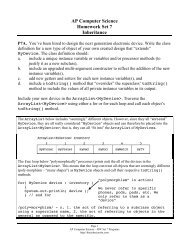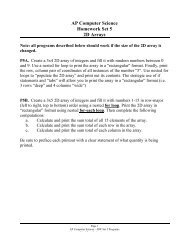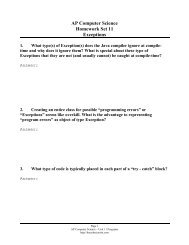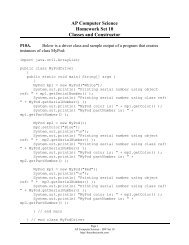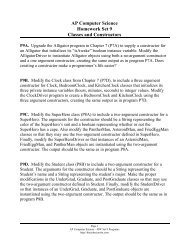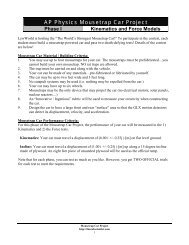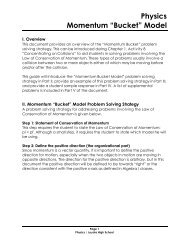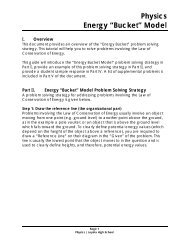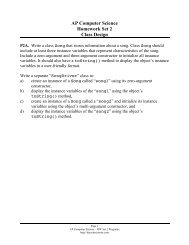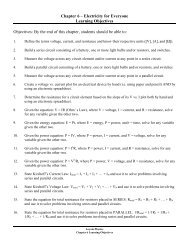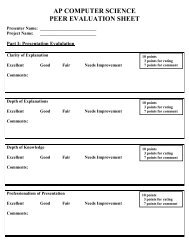Chapter 5 – Waves and Light Learning Objectives Objectives: By the ...
Chapter 5 – Waves and Light Learning Objectives Objectives: By the ...
Chapter 5 – Waves and Light Learning Objectives Objectives: By the ...
You also want an ePaper? Increase the reach of your titles
YUMPU automatically turns print PDFs into web optimized ePapers that Google loves.
<strong>Chapter</strong> 5 <strong>–</strong> <strong>Waves</strong> <strong>and</strong> <strong>Light</strong><br />
<strong>Learning</strong> <strong>Objectives</strong><br />
<strong>Objectives</strong>: <strong>By</strong> <strong>the</strong> end of this chapter, students should be able to:<br />
1. Draw a transverse wave <strong>and</strong> identify its amplitude, period, frequency, wavelength, nodes, crests, <strong>and</strong><br />
troughs.<br />
2. State <strong>the</strong> difference between transverse <strong>and</strong> longitudinal waves <strong>and</strong> be able to give examples of each.<br />
3. Given <strong>the</strong> equation: v = d/t, where v = velocity, d = distance, <strong>and</strong> t = time, solve for any variable<br />
given <strong>the</strong> o<strong>the</strong>r two.<br />
4. Given <strong>the</strong> equation: v = f, where v = wave velocity, = wavelength, <strong>and</strong> f = frequency, solve for<br />
any variable given <strong>the</strong> o<strong>the</strong>r two.<br />
5. Given <strong>the</strong> equation: T = 1/f, where T = period <strong>and</strong> f = frequency, solve for any variable given <strong>the</strong><br />
o<strong>the</strong>r.<br />
6. State how <strong>the</strong> frequency <strong>and</strong> wavelength of sound waves is affected when produced with an open-end<br />
pipe/tube vs. a closed-end pipe/tube.<br />
7. State how changing <strong>the</strong> tension of a string affects <strong>the</strong> frequency <strong>and</strong> wavelength of <strong>the</strong> sound wave<br />
<strong>the</strong> string produces.<br />
8. Know how to measure angles of incidence <strong>and</strong> angles of reflection for flat <strong>and</strong> curved mirrors.<br />
9. Know that a light wave will be bent when it travels from one medium to ano<strong>the</strong>r medium of different<br />
refractive index (index of refraction).<br />
10. Know how to measure angles of incidence <strong>and</strong> angles of refraction when light passes from one<br />
medium to ano<strong>the</strong>r.<br />
11. Know that <strong>the</strong> electromagnetic spectrum consists of waves from long wavelength to short<br />
wavelengths (radio waves, microwaves, infrared waves, visible light, ultraviolet, X-rays, <strong>and</strong> gamma<br />
rays).<br />
12. State that <strong>the</strong> visible light spectrum consists of <strong>the</strong> colors ROYGBIV (red, orange, yellow, green,<br />
blue, indigo, violet) in order of increasing frequency <strong>and</strong> energy.<br />
13. State <strong>the</strong> fundamental difference between a mechanical wave <strong>and</strong> electromagnetic (EM) wave.<br />
14. State <strong>the</strong> definitions of <strong>and</strong> give examples of supersonic, subsonic, ultrasonic, <strong>and</strong> infrasonic waves.<br />
15. Draw a ray diagram for an object for a flat (plane) mirror, locate its image location/orientation, <strong>and</strong><br />
determine whe<strong>the</strong>r <strong>the</strong> image it produces is real or virtual.<br />
16. Define <strong>and</strong> draw a tangent line <strong>and</strong> a normal line for a curved mirror or lens.<br />
Loyola Physics<br />
<strong>Chapter</strong> 5 <strong>Learning</strong> <strong>Objectives</strong>
17. Define <strong>and</strong> find <strong>the</strong> focal point for a concave <strong>and</strong> convex mirror.<br />
18. Draw a ray diagram for an object produced by a concave or convex mirror, locate its image<br />
location/orientation, <strong>and</strong> determine whe<strong>the</strong>r <strong>the</strong> image it produces is real or virtual.<br />
19. Draw a ray diagram for an object produced by a concave or convex lens, locate its image<br />
location/orientation, <strong>and</strong> determine whe<strong>the</strong>r <strong>the</strong> image it produces is real or virtual.<br />
20. Given <strong>the</strong> mirror equation: 1/f = 1/d i + 1/d o , where f = focal length, d o = object distance, d i = image<br />
distance, solve for any variable given <strong>the</strong> o<strong>the</strong>r two.<br />
21. Given <strong>the</strong> lens equation: 1/f = 1/d i + 1/d o , where f = focal length, d o = object distance, d i = image<br />
distance, solve for any variable given <strong>the</strong> o<strong>the</strong>r two.<br />
22. Know that <strong>the</strong> wave speed of ANY electromagnetic wave in a vacuum is <strong>the</strong> same (i.e. 3.0 x 10 8<br />
[m/s] or 186,000 [mi/s]).<br />
23. State <strong>the</strong> difference between color mixing <strong>and</strong> color subtraction with respect to light <strong>and</strong> pigments<br />
(paint) <strong>and</strong> explain whe<strong>the</strong>r a certain visible color is produced via color addition or color subtraction.<br />
24. Draw a ray diagrams for a reflector <strong>and</strong> refractor telescopes <strong>and</strong> be able to qualitatively explain <strong>the</strong>ir<br />
operation.<br />
25. Draw a ray diagram for a microscope <strong>and</strong> be able to qualitatively explain its operation.<br />
Loyola Physics<br />
<strong>Chapter</strong> 5 <strong>Learning</strong> <strong>Objectives</strong>




